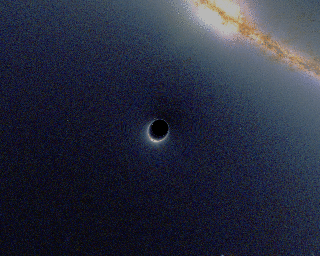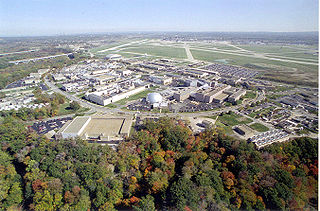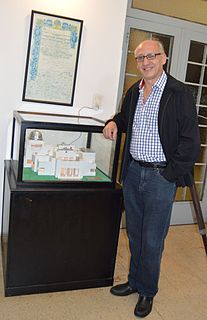This article has multiple issues. Please help improve it or discuss these issues on the talk page . (Learn how and when to remove these template messages)
|
The GAVRT Program is a partnership between NASA’s Jet Propulsion Laboratory (JPL) and the Lewis Center for Educational Research (LCER). GAVRT is an acronym for the Goldstone-Apple Valley Radio Telescope and provides a science investigation program for students K through 12. Students learn how to be part of a science team while they are making a real contribution to scientific knowledge by operating and collecting data on current NASA JPL missions to moons and planets in the Solar System.

The National Aeronautics and Space Administration is an independent agency of the United States Federal Government responsible for the civilian space program, as well as aeronautics and aerospace research.

The Jet Propulsion Laboratory (JPL) is a federally funded research and development center and NASA field center in La Cañada Flintridge, California, United States, though it is often referred to as residing in Pasadena, California, because it has a Pasadena ZIP Code.
The Lewis Center for Educational Research (LCER) is an educational organization located in Apple Valley, California. It is the parent organization of The Academy for Academic Excellence (AAE), the only research charter school in the state of California. The Lewis Center has a working educational relationship with NASA and operationally manages the Goldstone-Apple Valley Radio Telescope. The Lewis Center has three sites throughout Apple Valley:
Using the GoToMeeting platform, students take control of a 34 meter, 500 ton decommissioned NASA radio telescope to collect data for NASA’s Jet Propulsion projects. Students collaborate with scientists who are working on the same mission and are recognized as part of the science team.
GoToMeeting is a web-hosted service created and marketed by LogMeIn. It is an online meeting, desktop sharing, and video conferencing software package that enables the user to meet with other computer users, customers, clients or colleagues via the Internet in real time. In late 2015, Citrix announced plans to spin-off the GoToMeeting business as a stand-alone subsidiary with a market value around $4 billion. In July 2016, Citrix and LogMeIn announced plans to merge the GoTo family of products.
Current campaigns include studying black holes, planets, search for extraterrestrial life (SETI) and helping monitor the health of a space probes such as the Lunar Reconnaissance Orbiter, Cassini-Huygens space probe and the Juno space probe. This provides an opportunity for students to experience real science, to learn that science is an ongoing process, not just memorizing facts (Lewis, 2017).

A black hole is a region of spacetime exhibiting such strong gravitational effects that nothing—not even particles and electromagnetic radiation such as light—can escape from inside it. The theory of general relativity predicts that a sufficiently compact mass can deform spacetime to form a black hole. The boundary of the region from which no escape is possible is called the event horizon. Although the event horizon has an enormous effect on the fate and circumstances of an object crossing it, no locally detectable features appear to be observed. In many ways a black hole acts like an ideal black body, as it reflects no light. Moreover, quantum field theory in curved spacetime predicts that event horizons emit Hawking radiation, with the same spectrum as a black body of a temperature inversely proportional to its mass. This temperature is on the order of billionths of a kelvin for black holes of stellar mass, making it essentially impossible to observe.

The Lunar Reconnaissance Orbiter (LRO) is a NASA robotic spacecraft currently orbiting the Moon in an eccentric polar mapping orbit. Data collected by LRO has been described as essential for planning NASA's future human and robotic missions to the Moon. Its detailed mapping program is identifying safe landing sites, locating potential resources on the Moon, characterizing the radiation environment, and demonstrating new technologies.

Juno is a NASA space probe orbiting the planet Jupiter. It was built by Lockheed Martin and is operated by NASA's Jet Propulsion Laboratory. The spacecraft was launched from Cape Canaveral Air Force Station on August 5, 2011 (UTC), as part of the New Frontiers program, and entered a polar orbit of Jupiter on July 5, 2016, to begin a scientific investigation of the planet. After completing its mission, Juno will be intentionally deorbited into Jupiter's atmosphere.
Teacher training and certification is free and is available to all teachers across the world to learn the basics of radio astronomy, and are taught how to control the telescope. Teachers are provided free broad-based, multidisciplinary program curriculum which may be used as is, or individually adapted to fit their classroom environment that meets National Science Education Standards. Ongoing support for Teachers is provided by interactive website, email and phone communications. (Lewis, 2017).

Radio astronomy is a subfield of astronomy that studies celestial objects at radio frequencies. The first detection of radio waves from an astronomical object was in 1932, when Karl Jansky at Bell Telephone Laboratories observed radiation coming from the Milky Way. Subsequent observations have identified a number of different sources of radio emission. These include stars and galaxies, as well as entirely new classes of objects, such as radio galaxies, quasars, pulsars, and masers. The discovery of the cosmic microwave background radiation, regarded as evidence for the Big Bang theory, was made through radio astronomy.
The National Science Education Standards (NSES) represent guidelines for the science education in primary and secondary schools in the United States, as established by the National Research Council in 1996. These provide a set of goals for teachers to set for their students and for administrators to provide professional development. The NSES influence various states' own science learning standards, and statewide standardized testing.
Students recognize that they are part of a scientific team and have the opportunity to meet with, ask questions and discuss findings with NASA/JPL scientists and engineers via online communication programs such as SKYPE. Students work together in teams to plan the experiment, assign job responsibilities, collect and analyze the data obtained from the telescope. The radio telescope can be seen to move in real time via a projector. Students collaborate with mission control and take control of the telescope, they can see it move into position real time.















